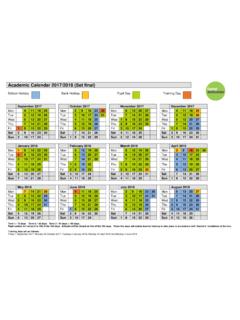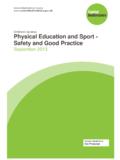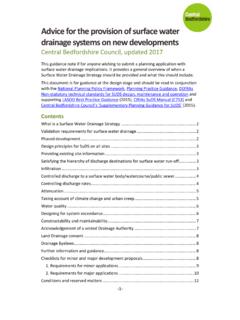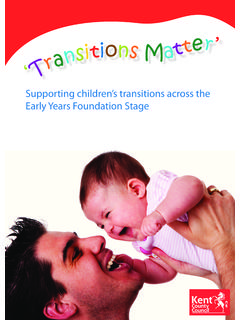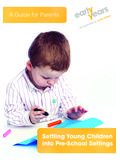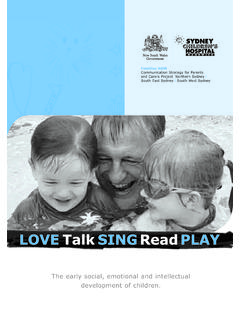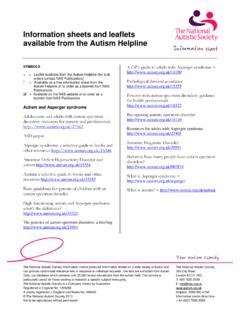Transcription of Smooth Transitions in the Early Years: a Good …
1 Central Bedfordshire inthe Early Years: a Good PracticeGuideProduced jointly by Early Years Teams including Schools, Pre Schools, DayNurseries, Nursery Schools, parents , Children s Centre Teacher, Child CareDevelopment Officers and Foundation Stage Advisory Teachers for children andfamilies with additional guide is designed to support all Early Years practitioners in Central Bedfordshire toprepare children for transition *. The guidance has been compiled in accordance withgovernment legislation and Transitions within the EYFS depend on a commitment from all professionalsinvolved to develop positive communication links. In order to promote continuity for allchildren experiencing Transitions between settings, it is important that there is a sharedapproach between all those professionals involved.
2 * transition for the purpose of this document, refers to any changes in provider thata child may experience, in particular the transfer of children to principles for good practice in supportingsuccessful earlyyears transitionsUnique Child Recognise that all children, can be vulnerable at times of change, particularly thosewith additional needs those with a Special Educational Need (SEN) or a child incare. Planning for these children will need additional, flexible support. Prepare the child for change. It is important that all children experience a positivetransition. With appropriate preparation and understanding, children are more likelyto feel secure and settle more easily into their new environment. It is here that theEarly Years Summary/Transfer Form can act as a supportive tool within thetransition Relationships Transitions can be eased by careful proactive planning, sharing of information andmutual visiting between parents , carers and professionals.
3 Listen to and acknowledge the important role of parents and carers throughout thisprocess Work together. An essential element of an effective transition is for settings andschools to work together, to establish a clear understanding of one another s aims,purpose and philosophy. Offer a range of opportunities for parents / carers to access information about thetransition process, open days, information events, consultations, Environments Children cope better with Transitions when conditions are similar, communication isencouraged, and the process of change takes place gradually over time The emotions that come with change can be successfully handled by children whentheir new setting/school has a clear, welcoming Learn and Develop in Different Ways and at Different Rates Ensure that consideration is given to the child s holistic needs.
4 It is important toensure that the continuity of children s experiences involves all aspects of their careand learningGuidelines for good practiceWhen preparing a child for school, it is important to remember that the preparation is notabout assessing his/her academic skills. It is about helping him/her to develop positive selfesteem and confidence. A positive disposition will promote a child s readiness for school. Visiting the new setting or school plays an important part in dispelling fears of theunknown. Encouraging the child to use a digital or disposable camera on such visitscan help to make the environment more familiar for the child. This supports apersonalised approach and the autonomy can be very empowering for the child. Thephotographs can then be shared by the child and discussed in the security of afamiliar setting.
5 Where an individual child transfers to a new setting, for example after movinghouse, the principles of good practice remain the same. The setting should aim tooffer the same positive transition experiences. Effective communication with parents and carers is crucial in ensuring a smoothtransition; children may disclose their concerns at home. Staff and parentrelationships need to be positive to ensure that this information is shared in orderthat the appropriate support is offered. Ideally parents , including fathers, should beinvolved in any planning as parents have a wealth of knowledge that professionalscan draw on. The key person has a particular role to play in supporting and preparing the child fortransition; particularly children who may experience feelings of sadness andresistance before leaving a setting, especially if he/she has been there for a verylong time.
6 Use stories to explore the new situations that the child will experience when he/shemoves. Stories, particularly open ended ones, can empower a child to reason andproblem solve independently. Acknowledge a child s relationships with both adults and children. Having friends inthe same class may help children adjust to the demands of the new environment. Recognise that a child needs time to settle and that a period of regression is quitenormal, for a child to stand and watch before joining in is quite usual andappropriate. Regular transition meetings between settings and schools enable importantinformation to be shared and transition arrangements agreed. A transition Policy will help clarify the process of transition for all stakeholders andensure that they are clear about the principles and practice.
7 A suggested modelpolicy is included in the parents and carers in the transition ProcessIn order to develop a shared understanding and an equal partnership, communicationbetween setting, school and parents / carers is essential during the transition and carers are their child s first and foremost educators. We need to listen to whatthey can tell us about their children and accept that as parents and carers , they have awealth of knowledge that we would do well to heed. We need to be knowledgeable about achild's ethnicity, language and dialect, community and locality if we are to offer them familiarsights, sounds and experiences that will help them settle. Sending a child to a new settingor class can be a daunting experience for parents and carers as well as children!
8 Manyparents and carers bringing their children to a setting for the first time may have unhappymemories about education and institutions. It is vital that we put ourselves in their positionand look closely at how we can make our settings and schools welcoming and lessthreatening to new parents so that they, in turn, can give positive messages to and carers are keen for their children to be happy and successful at school. Theywant to know that: their child will be safe and nurtured the school/setting will value the learning from home the school/setting will respond to and value children's cultural background the school/setting will respond to the needs of their child particularly if they havedisabilities the school/setting will get to know their child and respond to their a parent/carer fully in the transition process can reduce anxiety greatly for themand for their Who Attend More Than One SettingSome children will attend more than one setting during the course of the day, for example abreakfast club, school, after school club and/or a childminder.
9 For these children it is vitalthat all practitioners work in partnership to exchange information. The Summary/TransferForm should be completed by the setting where the child spends most of their time incollaboration with other provider information. Others settings attended by the child maycomplete a Summary/Transfer Form should they wish with Additional NeedsThe current SEN Code of Practice (2001) defines a child with a learning difficulty as a childwho has greater difficulty learning than the majority of children of the same age or has adisability which prevents or hinders the child from making use of educational facilitiesprovided for children of the same should be seen as a process which involves parents / carers , child, setting andreceiving setting.
10 (EYFS 2008) A child s transition from home to a preschool setting or froma setting to school can be an anxious time, particularly if there are additional needs withregard to their development of speech and language and communication, health andphysical needs or general development. Periods of change can be made less daunting ifparents and carers views are respected and they feel that they have made a suitablecontribution to what will happen when their child moves to a new setting. During a child s time in a preschool setting the setting Special Educational NeedCoordinator (SENCo) and the child s key person will have had regular meetings withparents or carers for discussion and to facilitate liaison with other professionals. As preparation for transferring to school a transition meeting for parents with theSENCo at the school and, when appropriate, other professionals supporting the childshould be arranged.

